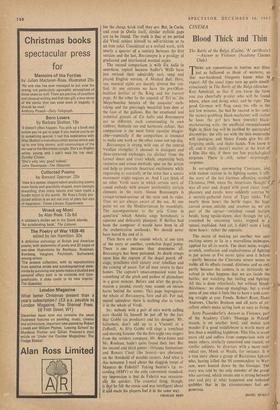CINEMA
Blood Thick and Thin
The Battle of the Bulge. (Casino, 'A' certificate.) —Answer to Violence. (Academy Cinema Club.) MHERE are conventions in routine war films I just as hallowed as those of westerns, so that war-hardened filmgoers know what to expect. All the usual types turn up quite unself- consciously in The Battle of the Bulge (director: Ken Annakin), so that if you know the form you can cheerfully predict who will be found where, when and doing what. and be right. The good German will fling away his rifle in the last few minutes, the bad be roasted in his tank; the money-'grubbing black-marketeer will realise he loves the girl he's been (merely) black- marketeering with: the unofficial reconnaissance flight in thick fog will be justified by spectacular discoveries; the silly ass with, the thin moustache will apologise, and Henry Fonda give his all- forgiving smile, and shake hands. You know it all, and it really doesn't matter, at the level of a film like this, if there are few psychological' surprises. There is still, rather surprisingly. suspense.
In ear-splitting, eye-wearing Cinerama, an with violent realism in its fighting scenes, it tells the story of the last German offensive, aroUn& Christmas 1944, when the Americans 'thought' ice was all over and, doped with good cheer, com- placency and carols, were suddenly overrun by a secretly-gathered force of Tiger tanks. Voi• nearly three hours the battle rages, the huge 'curved screen enfolds and involves us, we arc part of the uproar—switched round hairpin bends, hung upside-down, shot through the air, crunched by oncoming tanks, trapped in a tunnel, exploded. And yet, it didn't seem a long, three hours: rather the opposite.
The secret of making yet another war epic exciting seems to lie in a marvellous technique, applied for all its worth. The sheer noise, weight, scrunch, confusion and explosiveness of fighting is put across as I've never quite seen it before —partly because the Cinerama screen seems to treble all its effects (sound, dizziness and so on), partly because the camera is so intricately in- volved in what happens that we are inside the battles, not watching but feeling and fighting. All this is done relentlessly, but without blood- thirstiness: no close-up manglings, but a vivid sense of just what it feels like to have a tank com- ing straight at you. Fonda, Robert Ryan, Dana Andrews, Charles Bronson and all sorts of ex- cellent others make acting look as easy as living.
Jerzy Passendorfer's Answer to Violence, part of the Academy Club's 'Homage to Poland' season, is on another level, and makes you wonder if a good middlebrow is worth more or less than a middling highbrow. This film is seven years old and suffers from comparison with so many others, similarly conceived and treated, on similar subjects, by directors with a more indi- vidual eye, Munk or Wajda, for instance. It is a true story about a group of Resistance fighters who, having killed the SS commandant in War- saw, were hunted down by the Gestapo. The story was told by the only member of the group who survived, which means one is strung between awe and pity at what happened and technical quibbles that in the circumstances feel un- generous.
ISABEL QUIGLY






































 Previous page
Previous page